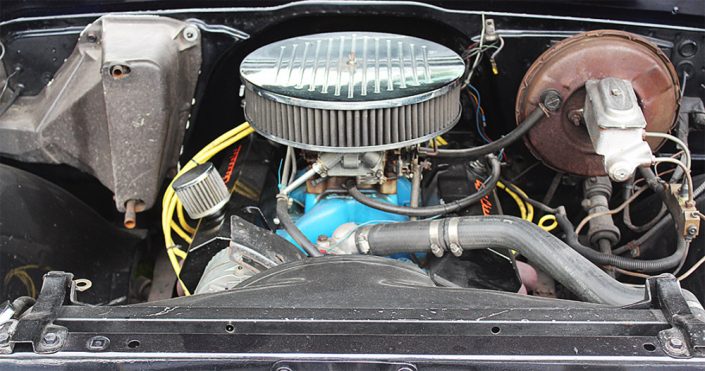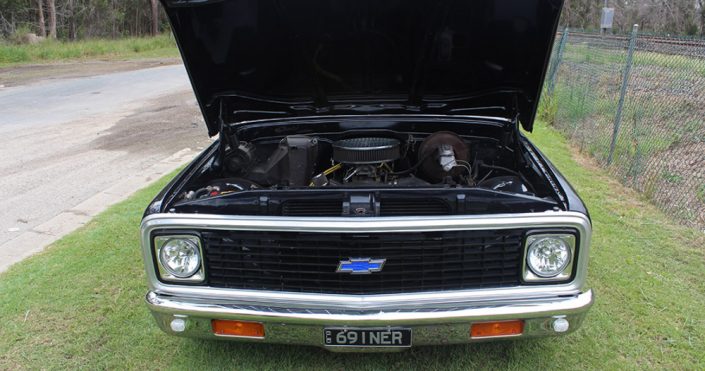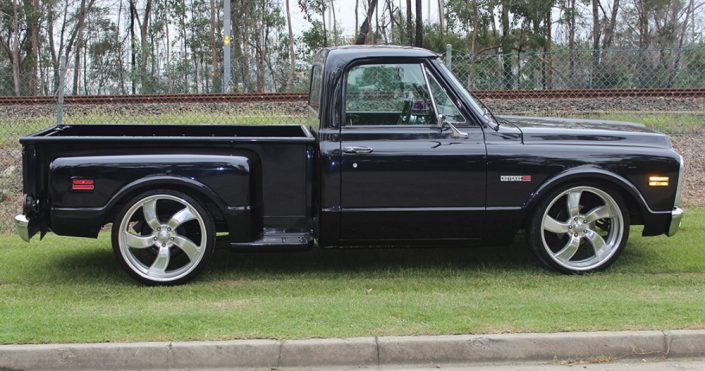2011 Ford T-Bucket (Replica)
OWNER: Steve Myers PUBLISHED: September 2015
In 1908, Henry Ford watched on as the first Model T rolled off the production line at his factory in Detroit. It was the start of an automotive revolution, ushering in mass-production assembly lines and making cars not just a symbol of luxury and wealth but something everyone could aspire to own. Fast forward 19 years, and more than 15 million of the little black cars were puttering their way along the world’s roads.
As Henry drove the last of the Model T’s off the production line in 1927, it’s likely that he imagined the world would move on, his famous creation consigned to a venerated place in automotive history while the public embraced the new and improved Model A. But the Model T didn’t just disappear into the history books, of course. Robust, incredibly numerous, and cheap, young men began to get their hands on them and began chopping and slicing them, putting in bigger engines, putting on wider wheels and giving the Model T a new life as the hot rodders’ favourite.
By the end of the 1950s, the most popular style of Model T hot rod had become known as the T-Bucket – a name bestowed upon them thanks to the use of the bucket-shaped body from the two-seater Model T roadster – and the T-Bucket style remains one of the most popular to this day. So popular, in fact, that with Roadster bodies becoming harder to find, an industry has developed building fiberglass replicas.
Steve Myers, from Myers Engine Reconditioning in Cairns, has owned this stunning T-Bucket for four years – taking advantage of the replica industry to buy a built-to-order chassis and fiberglass body and building up the car around them. It was a conscious decision to build a hot rod which, at the same time, was not a project that was terrifically complex.
“I bought a chassis and the bucket from a guy whose business is building them,” says Steve. “They come engineered and with the certificates ready to register it. So I started with that and bought bits here and there and built the rest of it myself. I always wanted to build a hot rod and a T-bucket is quite simple. So I thought I would build this one first, see if it worked out fine and then build another hot rod later.”
Steve already knew much of what he would be doing to the T-Bucket before he received the chassis and body. In fact, he had to tell the manufacturer what engine, gearbox and diff he would be using so that the chassis could be made to fit.
“I knew I was going to build it with a 350 Chev V8,” he says. “And I knew I was going to run the Chev with a Turbo 350 gearbox and a Jag diff. A lot of hot rods use Jag diffs because they’ve got independent suspension and they are nice looking too. And you take into account what things look like when you build one of these.”
However, as with the construction of just about anything these days, building a hot rod is not as simple as deciding what you want it to look like and what parts you are going to use. There are rules to be followed, including National Street Rod Registration guidelines, which involve submitting a ‘proposal to build’ outlining the technical specs of the car and allowing inspections during the build to ensure compliance.
“When you start the build you have to submit a ‘proposal to build’ and basically state what motor, what gearbox, what size wheels, everything, you are going to use,” says Steve. “Once you’ve done that you can’t really deviate from the proposal. For instance, I can’t now decide to put a Supercharger on mine because it wont be within those specs. There are only little things along the way that you can change – but not the fundamentals.”
But those ‘little things’ can be important. They influence the look and feel of the car. For instance, the wheels, the paint job, the interior – all play an important part in how a hot rod comes together. For Steve, this meant going a bit ‘old-school’ in design, and sourcing much of the parts, and indeed the look, from websites.
“Because I’m an engine reconditioner, finding the engine wasn’t really a problem,” he says. “I bought aluminium heads from the US and it’s got a twin-carby set-up on it from the States too. I sourced the front brakes from a Commodore and found headlights and other bits online. And because it’s a T-Bucket and they are a bit ‘old school’, I went for an old style mag set-up with the ‘jelly bean’ type.”
While Steve found parts online, the source for the deep blue paint job was a little more conventional.
“I like blue and I was at a local Holden dealer one day repairing a broken stud when I saw a new Commodore Ute. I said to the guy there, ‘What’s the name of that colour?’ He gave me the name and I went from there – so it’s a Commodore colour!
“As for the interior, I made the shape of the seat that I wanted and a friend upholstered the frame I made. The ‘old-school’ style electronic gauges I bought from the States.”
With the T-Bucket essentially finished 18 months ago, Steve hasn’t let the finished project sit idly in his garage. It might not be his everyday drive, but it certainly gets plenty of road time, and plenty of attention.
“Even if I take it out just for a half-hour drive I always get people waving to me,” he laughs. “I pull up at a set of lights and it’s not unusual to see somebody hanging out of the window of the car next to me taking pictures!”
There isn’t anything left to do on the T-Bucket – though Steve says he may yet put a roof on to protect against the sometimes unpredictable North Queensland weather – and with this car complete, he is turning his mind to future projects.
“I’ve usually always got a project on the go,” he says. “I can’t just sit around and watch TV at night time, so there’s always something happening!
1969 CHEVROLET C10 PICK-UP
Owner: DAVID DELAFORCE Published: May 2014
1969 was a year of contrasts. On the dark side of the ledger, the Vietnam War was in full swing, while, on a lighter note, humanity ‘spaced out’ at the Woodstock festival and then went out into space and landed men on the moon. When Neil Armstrong jumped onto the lunar surface pronouncing it a ‘small step’, planet earth watched in awe and begged to differ that it was anything but ‘small’.
1969 was also the year that David Delaforce’s Chevrolet C10 was built – a classic American pick-up that somehow found its way to these shores and, in 2010, to an auction house in Brisbane.
“I bought it from Pickles auctions,” says David. “Among other things, Pickles deal in damaged vehicles. We go every week and it just
happened to be there.
‘We’ is David and son Wayne, who works with David at the 8-acre Park Ridge Wreckers south of Brisbane, and who shares David’s passion for classic American muscle (he owns a 1968 Pontiac Firebird which we shall focus on in a future edition of MT).
The pair’s passion has seen a fair number of American classics pass through their hands over the years and sees them travel to the USA on a regular basis to purchase them.
In fact, when MT meets them, Wayne has just returned from a trip to the States to buy another batch.
It sounds like an expensive hobby but, according to David, it’s an affordable way to own classic vehicles – a reflection of the huge classic car business in the US, and their popularity here.
“We don’t have to import all the parts from the States,” he says. “A lot of stuff is available here. There are a lot of importers that are selling parts on a large scale for Chrysler, Chev, and Ford. It’s as simple as getting on the internet and dialling away and ordering. There’s not much they don’t make for the popular old model cars now.
“There are even quite a few C10s around. The 1957 model is starting to become really popular. In fact, my son just purchased one on his trip to the States.”
Seeing the vehicle ‘in the flesh’, so to speak, also means you won’t end up buying a lemon.
“There is a ‘buyer beware’ element to it,” says David of purchasing the cars from abroad. “We did buy a vehicle once, an Impala, without going over to see it and that was a mistake. It was a real rust bucket.”
As for David’s C10, it too needed a little work.
“It wasn’t in the best shape when I got it,” he agrees.
“Old American cars are well known for rust. If you ever buy one, check it out properly. The old ‘metal bug’ does get to them.
“Fortunately there wasn’t too much rust on this one apart from the doors. They were like Swiss cheese!”
“Apart from repairing the doors, we painted it, re-trimmed it, did the suspension and bought the wheels from the US. Inside, we put in new door rubbers and trim, new carpet and we re-did the seat.”
Unusually perhaps for a classic car owner, David uses the C10 for the purpose for which it was built – it is a working vehicle.
“It’s very good for that sort of thing,” he says of the C10’s practical abilities.
David can’t put his finger on why or how exactly he got into American muscle cars.
“One of my first jobs was working in a garage and I was always mucking about with cars,” he says. “But why American cars? I think it’s just the idea of them and the novelty of them. I also think you get more relaxation from driving older cars – you can go to swap meets and meet up with people with the same interests.”
“I’m not in a club, although that’s mainly because of the time needed to try and get away to events and so on. However, we have heaps of friends who drive old cars and we do meet up at different venues. There are nights when we go for a ‘run’ and we can get 200-300 cars joining us.”
“We have taken the C10 to a couple of car shows too, like the Shannons show at Willowbank and shows at Rochedale and Rocklea showgrounds.
“We also take half-a-dozen spots at the ‘Cooly Rocks On’ Show at Coolangatta each year,” he adds, referring to the huge nostalgia event held south of the Gold Coast each year to which he and Wayne take a number of cars from their collection. That’s an indication of how deep the passion for these cars runs in both men. And, no doubt, they will continue to scour the internet and travel to the States in search of classic American vehicles. It’s a passion, a hobby and, once that bug bites, it’s hard to give up.















